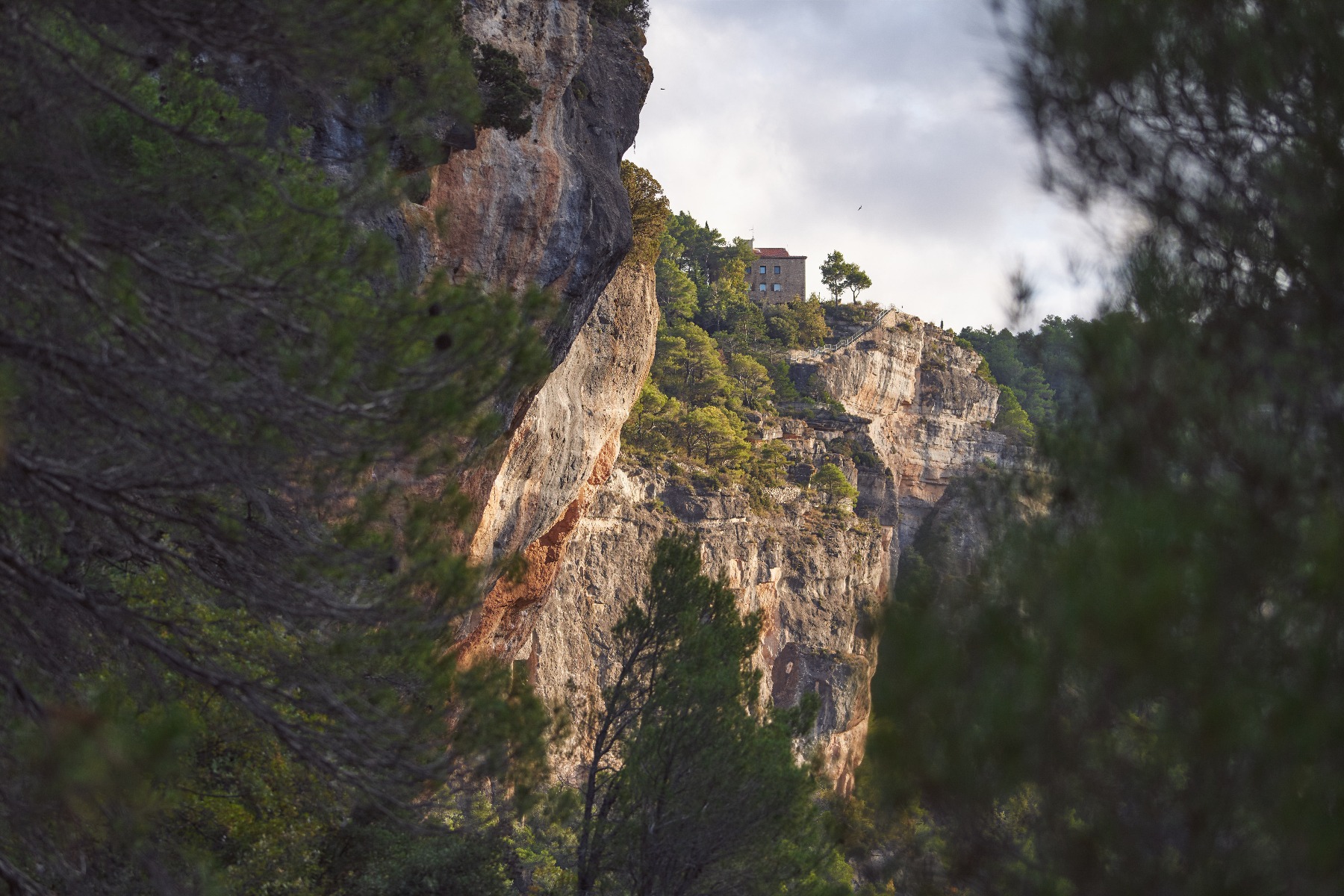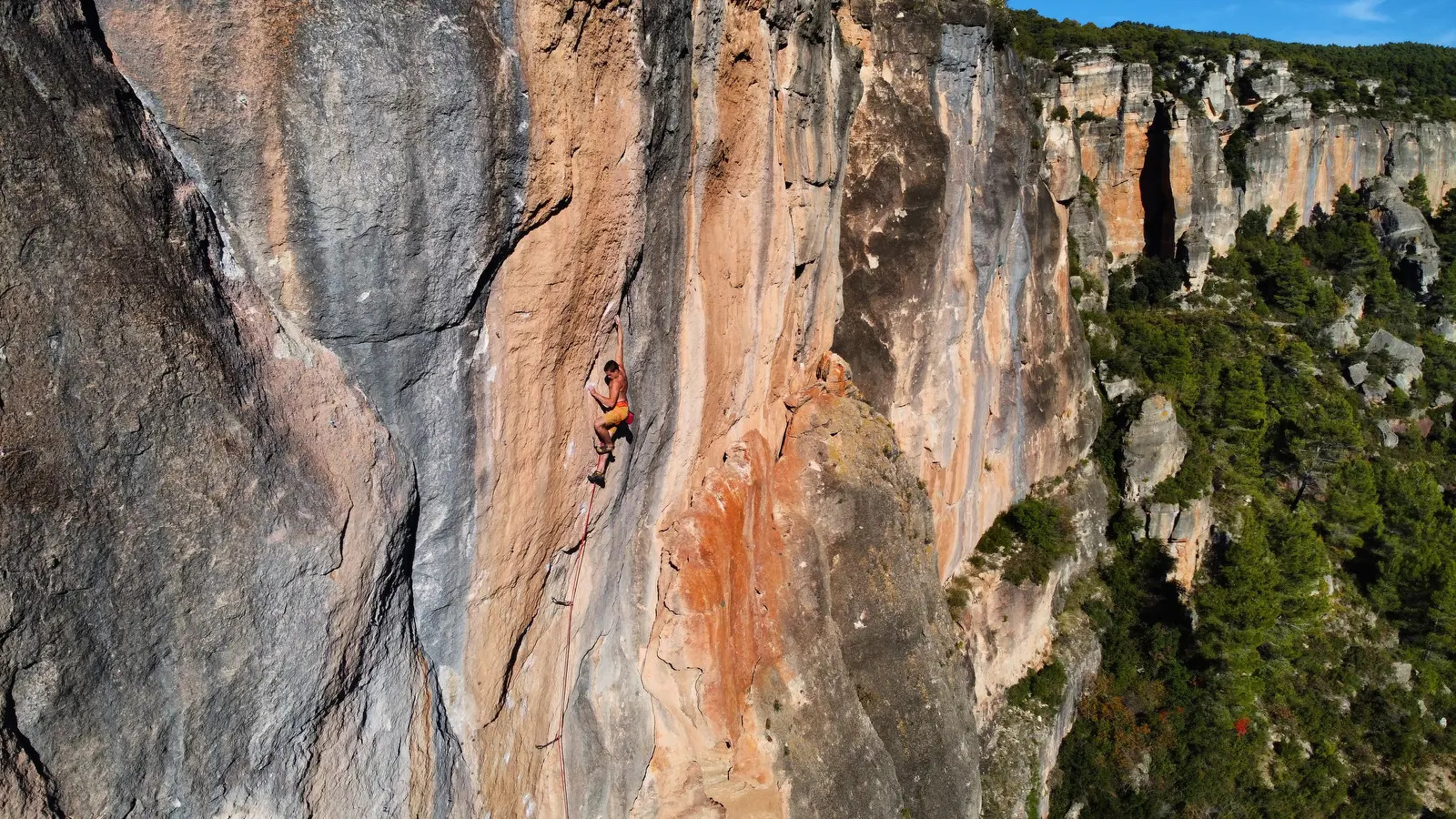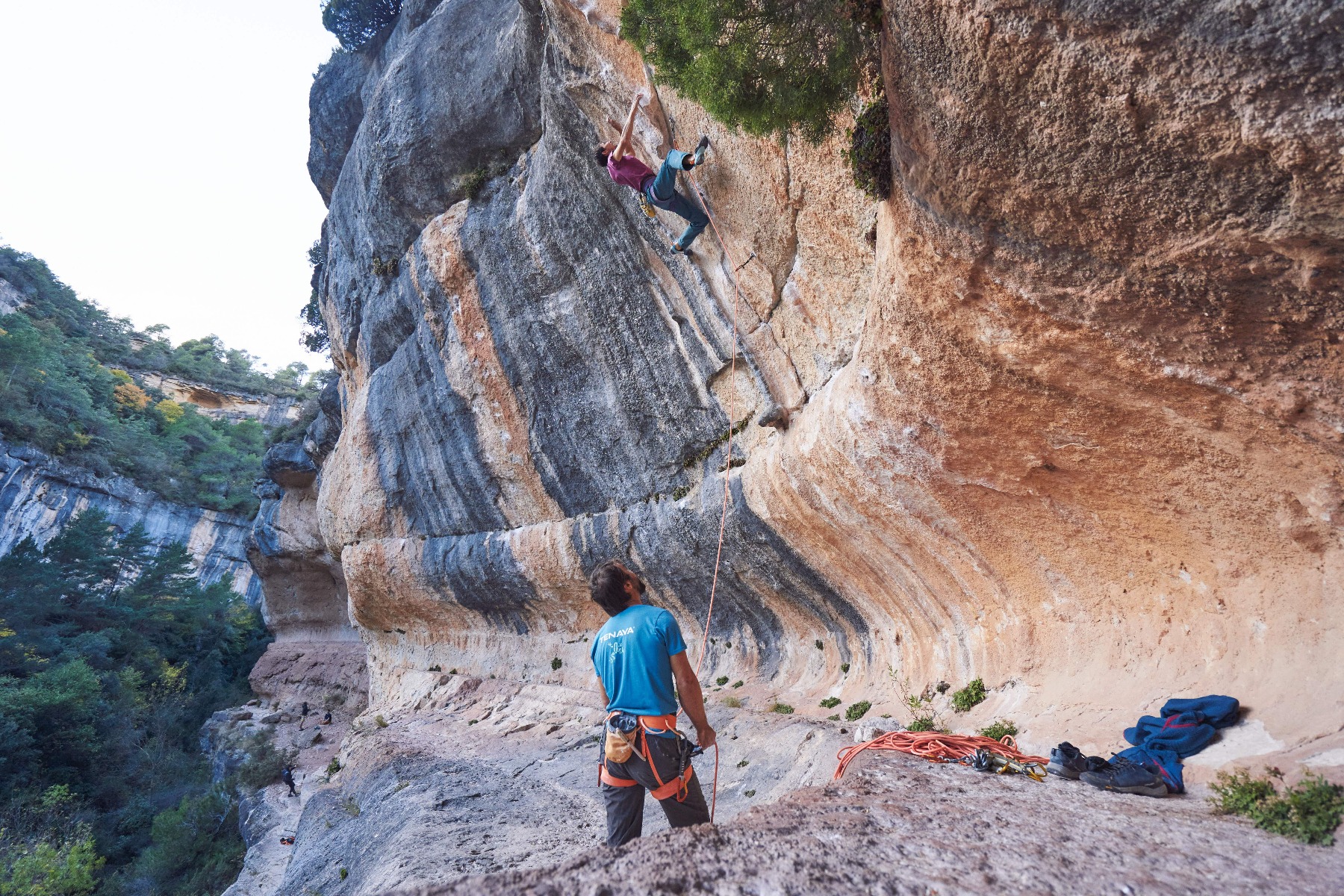Let's discover Siurana, with its 40 years of climbing history on its shoulders and the most classic sectors that have made it both a historic and extremely contemporary climbing destination.
Siurana is an absolute reference point for climbers from around the world, a climbing destination that needs no debate as soon as temperatures drop in the rest of Europe.
Frequented during the shoulder seasons, which consistently offer the best climbing conditions, it's also a destination that welcomes many climbers during the Christmas holidays. In the colder winter months, you can still climb by focusing on the south-facing sectors that often have names that already make us shiver with anticipation, unlike the typical damp cold of our regions. The Solarium is one of these.

Short Siurana history
Siurana blends history with a contemporary context. Routes, four decades old, run near new projects and First Ascents by today's climbers. Siurana's unique origin story deviates from traditional climbing areas. It was conceived for sport climbing with bolts and anchors, replacing the need to reach the summit. Visionaries like Joan Chaparro, Eduard Burgada, Joan Olivé, and Joan Cabau, along with more bolters, laid the foundation.
Siurana's development from Serra de Prades has been consistent and unstoppable. It's a top climbing destination, known for pushing high difficulty limits. The world's best climbers achieve memorable ascents on Siurana's rock. Chris Sharma recently completed Sleeping Lion in the El Pati sector, proposing it as a 9b+. Siurana's potential seems limitless.
Main historical moments
If there's one iconic image representing a historic moment in the history of women's climbing, it's undoubtedly the famous photograph of Margo Hayes after her ascent of La Rambla, the moment she realized she was the first woman to climb a 9a+. The route, originally established by Alex Huber in 1994, was later extended and freed in its now well-known form by Ramon Julian in 2003.
Apart from attracting some of the world's strongest climbers due to its numerous yet-to-be-freed projects, as was the case with Sleeping Lion until a few months ago, Siurana is also a place where many climbers test their mettle with onsight and flash attempts. One notable example is Alex Megos' onsight ascent of Estado Critico, a 9a route, in 2013, marking the first onsight ascent of this difficulty level.
Siurana Map
Siurana offers a plethora of climbing sectors scattered along the road leading to Cornudella de Montsant. To give you a sense of its location, it's about an hour's drive from Tarragona if we consider the coastal route and roughly an hour and a half from Lleida if we look inland. Surrounding Siurana, you'll find smaller and definitely less crowded crags like Villanova de Prades. Many climbers choose to combine a vacation in this area with a visit to the equally famous Margalef, which is located about 30 kilometers away.
Both Margalef and Siurana boast over 2,000 routes to test your finger strength. Margalef primarily features conglomerate rock, while Siurana offers limestone with varying characteristics depending on the sector. The routes are often quite lengthy, and the consistently challenging terrain results in technical climbing. Success here relies on finger strength and an impressive dose of endurance, making for a satisfying climbing experience.
Siurana climbing areas
The brand-new 2023 guide, authored by David Brascó and Natàlia Campillo, divides the vast expanse of Siurana's rock into five main areas, each containing numerous sectors. We've picked out five sectors that, in a way, encapsulate the essence of climbing in this region and encapsulate key chapters in the history of climbing that unfolded right here. Some of these sectors played a central role in various Master of Stone and Dosage events during the late '90s and early 2000s.
This new guide provides meticulous details for every aspect. Along with the route developer's name and the year it was established, the author offers recommendations on must-visit sectors, the most beautiful routes, and routes now considered universally "easy for the grade." You'll find information on sun exposure, approach routes, and geolocation data for parking areas and crags. This guide is an indispensable tool if you're planning a visit to this area.
Siuranella Sud and Centro: we may not need anything else for a whole holiday

Siuranella represents, in many aspects, the heart of the entire Siurana area, the ultimate destination for a wide range of climbers who don't need to find a 9a route to have fun. Siuranella Sud is the ultimate winter sector, perfect for intermediate to advanced climbers (but still human) who excel from 7a and beyond. Here, you'll find around thirty routes ranging from 22 to 30 meters in length, on diverse rock features including cracks, corners, and technical, finger-intensive walls. The flat base, sun exposure, and relatively short approach (about 15 minutes) make it highly frequented during the winter months, even by families.
Siuranella Centro continues from the Siuranella Sud wall and is slightly more shaded in the late afternoon. Here, you can discover nearly 70 routes, most of which fall between 7a and 7c, with more variety in the easier grades (there are almost ten routes ranging from 6a to 6c) and a few 8a routes waiting for the strongest climbers. The spectacular location adds to the charm of this sector, leaving you with something more than the satisfaction of a "typical day at the crag." The quantity and quality of routes undoubtedly make both sectors suitable for everyone.
Siuranella Est
A magnificent sector with a wide variety of routes and styles, characterized by consistently high intensity. Most of the routes range from 7a to 7c, while the 6b and 6c routes are considered the "warm-up" classics. What sets Siuranella Est apart is its somewhat exposed and elevated position. To reach the base of many routes, you'll need to use fixed ropes on short sections equipped with iron steps. However, the ledges from which many routes start offer a unique climbing experience, adding a touch of magic to the pure act of climbing.
Despite being a natural extension of Siuranella Sud and Centro, the new guide places it in Area B, mainly due to different parking areas. In this case, we are situated around the Fontscaldes area, which is also popular among hikers and where it can be challenging to find available parking spots for cars and vans. To climb safely in this sector, you should equip yourself with a rope that is at least 80 meters long and pay close attention to the guide's instructions regarding the route lengths, especially in the Paret des Diedres.
El Pati

We now arrive at one of the most legendary sectors in Siurana, home to many emblematic high-difficulty routes that we've all heard of. Here, you'll find La Rambla, a historic route we mentioned in the introduction, as well as Golpe de Estado, rated 9b, and Estado Critico, rated 9A. This sector is the kingdom of the eighth grade, with just under twenty routes ranging from 6a to 7c. However, it's worth a visit for anyone passing through this area.
The routes here are often quite long, some reaching up to 40 or 45 meters, demanding high levels of strength and endurance. Thanks to its southwest exposure, it remains shaded until early afternoon, and its inclination makes it climbable even in light rain. Access from the parking area is minimal and suitable for climbers of all sizes. There's really no excuse not to at least take a look at this sector, brimming with stories, characters, and important chapters in the sport of climbing!
Esperò Primavera
Until now, we've been discussing sectors primarily tailored to intermediate or advanced climbers. However, with Esperò Primavera, we broaden the range of possibilities, reaching out to a crowd more comfortable with difficulties ranging from 6a to 6c. This sector is almost entirely exposed to the south, making it a popular choice during the winter due to its stunning rock quality, a quick approach that takes less than ten minutes, and a conveniently flat base.
Notably, Esperò Primavera is also home to historical routes that were first explored and bolted in the 1990s. For this reason, Esperò Primavera is considered a shrine of climbing in Siurana, an essential sector that encapsulates the very best of climbing in this area.
Can Piqui Pugui
Can Piqui Pugui is another must-visit and historically significant sector. Here, you'll discover "L’Odi Social," the first 8c route in Siurana and all of Catalonia, dating back to 1992, which is a remarkable 31 years ago. On this wall, a series of high-difficulty masterpieces follow one another: Chican, an 8c+ route freed by Ramon Julian in 2003, and A Muerte, also an 8c+ route bolted in 1994 by Alex Huber and Toni Arbones, later freed by Rich Simpson.
In addition to these challenging routes, you'll find numerous historical yet "easier" options, such as Gamba Gamba, a 7b route bolted in 1991 by Yuji Hirayama and Saiko Dase. There's also a 6b+ route, bolted by Yuji Hirayama along with local climbers Arbones and Brascò. Whether you prefer shorter and more intense routes, with lines as short as twelve meters, or resistance masterpieces on longer lines spanning 30 meters, this sector has it all. The routes range from slab to slightly overhanging walls, and it falls into the shade in the late afternoon.
La Capella
La Capella is one of those relatively small sectors where climbers go with the specific intention of attempting their "mega project." Here, you'll find just a handful of routes ranging from 7a to 7c, and then you move into not just challenging, but directly extreme grades. If the sector's name rings a bell, it's likely due to the 9b+ route called King Capella, bolted by David Brasco and freed by Will Bosi in 2021. This route adds to the already impressive number of routes graded 8a and above, making this sector a small "mecca for a select few."
Nevertheless, it's worth a visit. The 2-minute approach from the parking area mentioned in the guide justifies a stroll to witness this intriguing overhang.
A little chat with David Brascò, the author of the new Siurana climbing guidebook
Hi David, we have so far introduced some classical sectors, most of them highly appreciated by high-level climbers. Could you tell us which could be the sectors you would advice to beginner and intermediate climbers?
Hi! Thanks for your interest and for your intention to deepen the climbing besides high grades. There are a lot of possibilities also for intermediate climbers: around Barranc del Marro and Fontscaldes you will find L'Herbolari and Esperó Primavera. In the surroundingds of Rio Siurana, I would advice sectors like Can Gans Dionis, Can Marges, Can Parasit, Ca L'Orro, Grau del Masets esquerre, Grau dels Masets de Baix, Can Maquis or El Ditot. More than this, there are many other smaller sectors I don't have listed here: they are little gems that deserve tio be visited and climbed by everyone. You just have to look for them and to find the most unknown sectors off the typical busiest sectors. Or, you can also ask to local climbers to know more. For beginner climbers you have less choice but I could suggest to visit Belbedere in Esperó Primavera, Mr. Pin, Can Weekend, Can Marges and Can Parasit.
Siurana is often considered one of the best winter climbing destinations, perfect to spend your Christmas Holidays. Which sectors would you choice to climb in full winter?
If there is no wind, any south our south-east oriented sector could be a good choice, as for example Siuranella Centre or Reina Mora. If there is a windy day, it could be better to go to southeast oriented sectors, that is to say to Can Piqui Pugui or Grau dels Masets. Of course there are many more sectors, it just depends on your preferences and power!!
Which are the most recent sectors to be bolted?
Lately there hasn't been a huge bolting activity, but maybe the sectors equipped for beginners are the newest ones. I would say they could be Belbedere de l'Esperó Primavera and Mr. Pin.
Siurana continues to be a top destinations for climbers from all over the world, despite the passing of years: which are in your opinion the secret ingredients that determine this amazing success of Siurana?
I think it's not easy to find such a combination of strengths in so many aspects when you are planning a climbing trip. The quantity and quality of the routes and of the rock, the possibility to visit other climbing areas in the nearby, the beauty of the landscape and the many logistic facilities. There are a lot of crags in the world that have a better rock, or a better surroundings, but they rarely have all these aspects tied together as in this magic place. Siurana.
Siurana Climbing Festival

In November, Siurana becomes the setting for its namesake Climbing Festival, dedicated to anyone who wants to immerse themselves fully in three days of rock climbing, in-depth technical insights, and topics related to sport climbing.
From November 9th to 11th, enthusiasts will gather around Cornudella de Montsant to experience every aspect of their passion for climbing. The event features workshops with professional climbers spread across the sectors of El Pati, Esperò Primavera, la Olla, and Siuranella. There will also be seminars with photographers and yoga instructors.
You can find all kinds of information, including event details and logistical information, as well as book your workshops and start planning your trip to Siurana, on the official Siurana Climbing Festival website.
Foto credits: ©LiqenStudio_ Tenaya _ Siurana Climbing Festival 2022
